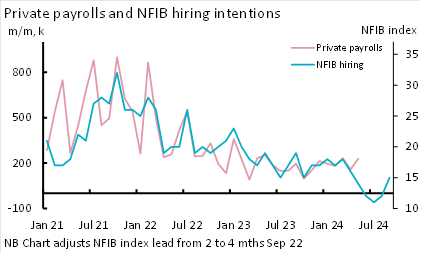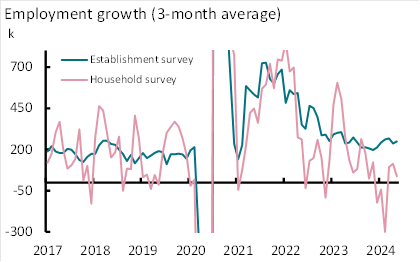
US reaction: US payrolls in ground hog day surprise
- 07 June 2024 (3 min read)
Not for the first time, we open today’s reaction with the words “Payrolls once again defied ours and market expectations”. Headline payrolls in May rose by 272k, marginally faster than the 267k average expansion over Q1. However, this was materially stronger than the 180k consensus (and our own forecast for a weaker 150k) and the downward revised 165k (from 175k) posted last month. The 3-month trend rose to 249k. Part of the increase was due to a partial rebound in government employees, those rising by 43k in May from just 7k in April, although somewhat softer than the 60k average of the previous five quarters. However, the real surprise was in the marked rise in private payrolls to 229k from 158k. This defied consensus forecasts for 165k, the 34k decline in the ADP survey and the drop suggested by the NFIB survey that has proven a remarkably good guide to private payrolls over the past 3 years (Exhibit 1).
A broader view of May’s employment report starts to ask broader questions. First, the household survey measure of employment fell by 408k – its biggest one-month drop since December. We have highlighted the divergence in the two measures previously and the current divergence in trend is not as great as it has been in the past (Exhibit 2). Moreover, we argue that this series is being affected by the impact of significant immigration not yet fully captured in Census Bureau population estimates. And we know that this series is more volatile. However, the household survey captures elements that the Establishment survey only estimates in its companies births/deaths factor at this stage.
This drop pushed the unemployment rate up to 4.0% - its highest since January 2022. This was despite the fact that labour force was estimated to have contracted by 0.15% on the month, its sharpest fall this year – despite continued evidence of strong immigration into the US. This in turn reflected a 0.2ppt drop in participation to 62.5% - its joint lowest since January 2023. At 4.0% the unemployment rate is 0.6ppt higher than its latest low 13-months ago. However, the change is 0.37ppt higher in the three month average trends used to calculate the Sahm effect, which has historically been used to identify recession. Relatedly, we note that quite apart from the fall in May’s labour force, labour supply growth has been decelerating from an average annual 1.7% in 2023 to just 0.5% now. This looks questionable in the face of alternative immigration numbers that have continued to increase sharply.
Finally and perhaps most importantly, total average hourly earnings rose by more than expected, up 0.4% on the month in May (compared to a 0.3% expectation), while non-supervisory earnings rose by 0.47%, taking annual rates up to 4.1% and 4.2% respectively. The 3-month annualized rate of total earnings rose back to 4.1% in May, from the 3½ year low of 3.0% last month. We argue that 4.1% is not far from the pace consistent with the Fed’s 2% inflation target, but it is likely above it and still modestly too elevated for the Fed to consider a serious argument to loosen monetary policy just yet.
Taken in the round, today’s payrolls report raise more questions than answers and have displayed some volatile moves in most key areas. The Establishment Survey has continued to come in stronger than expected and although we continue to expect a weakening in the months ahead and hold out some expectation of downward revision to today’s preliminary figure, we do so with less conviction than before. The Household Survey remains weak, both in employment and in labour supply terms, but we acknowledge that this survey is inherently more volatile and we think impacted by population estimates. And pay growth has surprised modestly to the upside. We do not think this will have a major impact on next week’s FOMC meeting, but if anything it will urge more patience before easing policy, serving more to keep the FOMC in an uncommitted, “data dependent” mode. We expect the FOMC’s dots next week to shift to two cuts for this year and maintain our own outlook of two cuts in September and December.
Short-term rate markets reacted to the release, pricing for a September rate cut jumped from 85% this morning to 60%, with expectations for two cuts pared back to 60% from over 90%. As such, 2-year Treasury yields jumped 13bps to 4.84% and 10-year yields 12bps to 4.41%, undoing most of the steady gains Treasuries have made this week. The dollar also rose by 0.7% against a basket of currencies.
Exhibit 1: Private payrolls posts surprise gain

Source: BLS, June 2024
Exhibit 2: Divergence between two measures persists, but not at extreme

Source: BLS, June 2024
Related articles
View all articles

European Parliament and French elections: Investor update
- by , ,
- 24 June 2024 (10 min read)

UK reaction: Back at target
- by
- 19 June 2024 (3 min read)

EM Latin America reaction: A positive start to 2024
- by
- 18 June 2024 (5 min read)

US reaction: CPI notches 2nd confidence builder
- by
- 12 June 2024 (3 min read)
Disclaimer
The information on this website is intended for investors domiciled in Switzerland.
AXA Investment Managers Switzerland Ltd (AXA IM) is not liable for unauthorised use of the website.
This website is for advertising and informational purpose only. The published information and expression of opinions are provided for personal use only. The information, data, figures, opinions, statements, analyses, forecasts, simulations, concepts and other data provided by AXA IM in this document are based on our knowledge and experience at the time of preparation and are subject to change without notice.
AXA IM excludes any warranty (explicit or implicit) for the accuracy, completeness and up-to-dateness of the published information and expressions of opinion. In particular, AXA IM is not obliged to remove information that is no longer up to date or to expressly mark it a such. To the extent that the data contained in this document originates from third parties, AXA IM is not responsible for the accuracy, completeness, up-to-dateness and appropriateness of such data, even if only such data is used that is deemed to be reliable.
The information on the website of AXA IM does not constitute a decision aid for economic, legal, tax or other advisory questions, nor may investment or other decisions be made solely on the basis of this information. Before any investment decision is made, detailed advice should be obtained that is geared to the client's situation.
Past performance or returns are neither a guarantee nor an indicator of the future performance or investment returns. The value and return on an investment is not guaranteed. It can rise and fall and investors may even incur a total loss.
AXA Investment Managers Switzerland Ltd.

